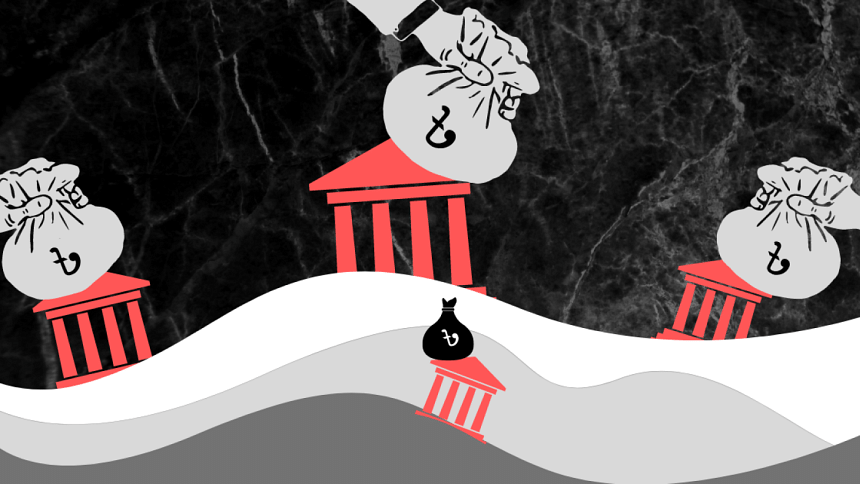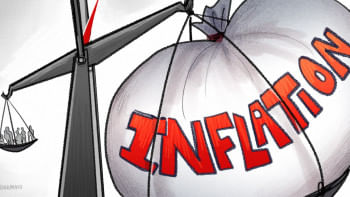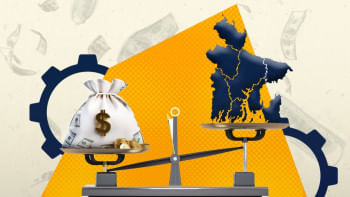Will the budget offer a path out of the debt spiral?

Bangladesh's debt burden is inextricably linked to the nature of its political system. Over the decades, authoritarian and autocratic regimes have forced rapid increases in debt. During General Ershad's regime, between 1982 and 1990, foreign debt more than doubled. Under Sheikh Hasina's oligarchic rule, the debt surged by 322 percent, rising from $23.5 billion in June 2009 to $99 billion in June 2023. State patronage has been systematically weaponised to cling to power.
The interim government inherited an economy under strain—high inflation, a revenue administration rife with corruption, a sluggish budget, a liquidity crunch in the banking sector, and dwindling foreign exchange reserves.
With the 2025-26 budget approaching, three core questions emerge: how can the debt burden be alleviated? How might domestic resource mobilisation be strengthened? And how can financing be secured to address post-COVID poverty and income losses? This article examines the first.
Climbing towards a cliff
Over the past 15 years, Bangladesh's public debt has swollen by over Tk 1 trillion—i.e. Tk 100,000 crore annually. The debt-to-GDP ratio is forecast to be 41.41 percent at the end of the current fiscal year. The total public debt reached Tk 18.3 lakh crore by the end of the last fiscal year.
In the first 11 months of FY2024-25, the government borrowed Tk 1,08,371 crore from commercial banks—57 percent higher than the previous year. Debt to scheduled banks totalled Tk 4,85,000 crore as of May 12. Net borrowing from the central bank reached Tk 56,116 crore. Though still under international risk thresholds, the current debt poses serious vulnerabilities.
Mounting debt repayment
Debt servicing is escalating. In FY2024, foreign debt repayments rose by 26 percent to $3.36 billion, with interest payments alone increasing by 44 percent. Over the past nine months, repayments climbed nearly 25 percent over the previous fiscal year. Debt repayment consumes more than half the national revenue budget.
The FY26 budget will reportedly allocate Tk 122,000 crore for interest payments alone—an increase of Tk 8,500 crore from last year. Interest on domestic debt will rise from Tk 93,000 crore to Tk 100,000 crore; on foreign debt, from Tk 20,500 crore to Tk 22,000 crore. This reflects not just rising debt but also higher interest rates and a depreciating taka. Without structural reform, the cost of debt will continue to crowd out development spending.
Contracting fiscal space
Fiscal space is shrinking. The Centre for Policy Dialogue had estimated that an improbable 55 percent revenue growth would be required in the last six months of FY2025 to hit the annual target, after recording just 4.4 percent growth in the first half. On the spending side, budget implementation is dismal. Only 41 percent of the Annual Development Programme was implemented in 10 months—a historic low in five years. Weak public financial management and a narrow tax base, riddled with evasion and corruption, continue to stymie progress.
Debt-financed patronage, not productive expansion
Much of the borrowing over the past decade was abused to consolidate power, not generate growth. Projects labelled as "development" were often vehicles for patronage, plagued by delays, inflated costs, and misaligned priorities. Many have yet to produce meaningful economic returns, compelling repayments from other sources—or more debt. Private investment has remained stagnant for long. Export diversification is sluggish. Small and medium enterprises face persistent barriers.
There is little talk of industrial policy, competitiveness, or productivity—the very things needed to create jobs and transform the economy. The root of these challenges lies in deep institutional weakness. Without reform, the budget will continue to be a tool of regime maintenance, not development.
Escaping the trap of 'borrowing to repay debt'
The upcoming budget has the opportunity to present strategies to reduce the debt burden. A five-point strategic framework is offered here.
First, leveraging the interim government's rapport with the United Nations, a formal request could be made to the Secretary-General to establish an independent commission to examine the questionable debt incurred under the autocratic regime. The government could refer to UN Security Council Resolution 1483, which provided legal protection against creditor lawsuits in the case of Iraq, to argue for a suspension of certain debt repayments. Past precedents—from Tsarist Russia's repudiated debts and Poland's write-offs under the Treaty of Versailles, to more recent examples like the United States' cancellation of Iraq's $125 billion debt in 2003—could be used to build a moral case for debt relief. The government has at its disposal seasoned UN experts who could help steer the process.
Second, a debt-for-development swap strategy could be negotiated with lenders to convert foreign debt into domestic investments in climate resilience, education infrastructure, and universal healthcare. This approach would create long-term goals of equitable and sustainable development while mitigating the anticipated decline in foreign aid in the post-LDC graduation era.
Third, expenditure prioritisation and the use of efficient strategy can be institutionalised through a comprehensive expenditure review framework, cost-benefit criteria for new projects, and performance-based budgeting. Fragmented and erroneous social safety nets must be consolidated under a unified authority to establish a universal, life-cycle-based social security system.
Fourth, a robust debt management strategy rooted in a Medium-Term Debt Management Framework (MTDF) can stabilise public debt through better liability management, reduced rollover risks, and lower borrowing costs.
Fifth, reducing dependence on short-term borrowing is essential to limit government liabilities. Excessive borrowing from commercial banks must be curtailed to prevent crowding out private credit.
The combination of revenue pressure, monetary policy tightening, and financial fragility poses significant risks to macroeconomic stability. Long-term stability demands coherent fiscal strategies, structural reforms, and institutional strengthening to advance inclusive, sustainable development.
The debt burden has not yet dangerously spiralled out of control. The IMF and World Bank support packages provide short-term liquidity. To address root causes, Bangladesh needs to move beyond conventional approaches and adopt creative solutions aligned with its political economy and development goals.
Dr Rashed Al Mahmud Titumir is professor at the Department of Development Studies, University of Dhaka.
Views expressed in this article are the author's own.
Follow The Daily Star Opinion on Facebook for the latest opinions, commentaries and analyses by experts and professionals. To contribute your article or letter to The Daily Star Opinion, see our guidelines for submission.

 For all latest news, follow The Daily Star's Google News channel.
For all latest news, follow The Daily Star's Google News channel. 







Comments